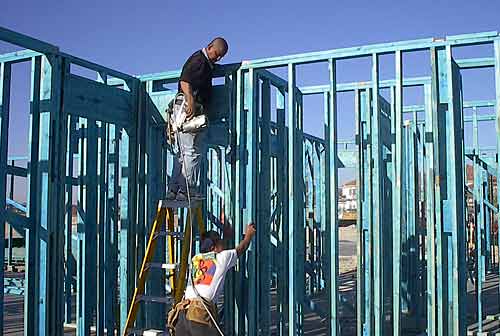Preventing Moisture-Related Problems in Residential Wood Framing
Impact on Structural Integrity
The two-step coating process can be applied to all wood components without compromising their structural integrity.
Pressure treatments can only be used on solid, dimensional lumber. Any attempts to pressure treat plywood, OSB, or EWP will void the structural properties of these wood-framing components.
Installation Restrictions
Wood that has been treated in the two-step process does not require
any special handling. These components can be sawed, mechanically anchored, adhered, and painted just the same as untreated wood
components. The factory coating does not apply significant extra weight to the components either.
Pressure-treated wood is impregnated with chemicals and requires special consideration when being installed into a residential project. Sawdust from pressure-treated wood can be an irritant to the nose, eyes, and skin. Direct skin contact should be prevented and the use of both dust masks and eye protection is highly recommended when working with pressure-treated wood.
Pressure-treated wood tends to cup as it dries and it becomes prone to splitting. To prevent splits, contractors should pre-drill any nail or screw holes within an inch of the end of the board. This lessens the chance that the board will split, while the installation team is fastening it.
|
When wood is pressure-treated, it essentially becomes a piece of wood soaked in chemically treated water. This water-soaked wood is much heavier than dry lumber, often weighing in at 38 pounds per cubic foot of wood, and can cause installation headaches and backaches for the contracting team. This weight dissipates as the water evaporates.
Weathering and Warping
The predisposition to twisting, cupping, splitting, and bowing is one of the weaknesses of using wood. The porous nature of wood naturally allows for the rapid absorption of moisture and rapid moisture loss as the wood dries in the sun and air. This rapid, un-controlled absorption and loss of moisture causes the warping, wracking, and checking in wood components.
The semi-vapor permeable film applied to each side of the wood as the first step of the two-step process adds a control mechanism to the absorption and loss of moisture within wood, slowing the vapor transfer. This added control conditions wood components to resist twisting, cupping, and splitting and provides builders with more usable wood on the job site, especially when the framing package has been delivered to the job site and exposed to rainfall or high moisture. Specifically, this conditioning process has been credited with reducing lumber waste factors by as much as 50% on extended projects where wood framing is exposed to the weather for longer periods of time.
The pressure treatment process is designed around the porous nature of wood. This process accelerates the natural absorption rate of wood by soaking wood in a highly pressurized environment designed to drive water and chemicals deeply and quickly into wood pieces.
Then, pressure-treated lumber is shipped to the lumber yard in stacks that are tightly bundled and often damp. By the time these bundles arrive on the job site, they are often a combination of straight and warped wood pieces. The warped pieces were invariably on the outside of the bundle, exposed to direct sunlight and air. This exposure caused one side of the wood to dry faster than the other, and, subsequently, warping occurred.
The rapid absorption and loss of moisture inherent in the pressure treatment process may explain why pressure-treated wood tends to cup as it dries. Cupping occurs when wood bends along its width away from the bark side. This wood is also sensitive to splitting and cracking as contractors work to fasten this protected wood onto the project.










